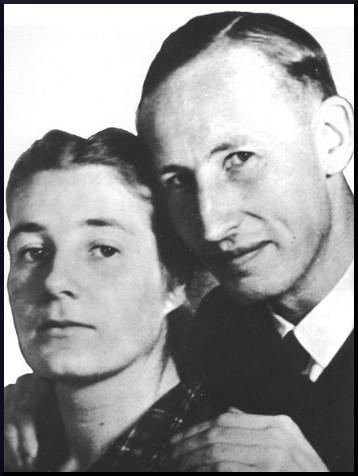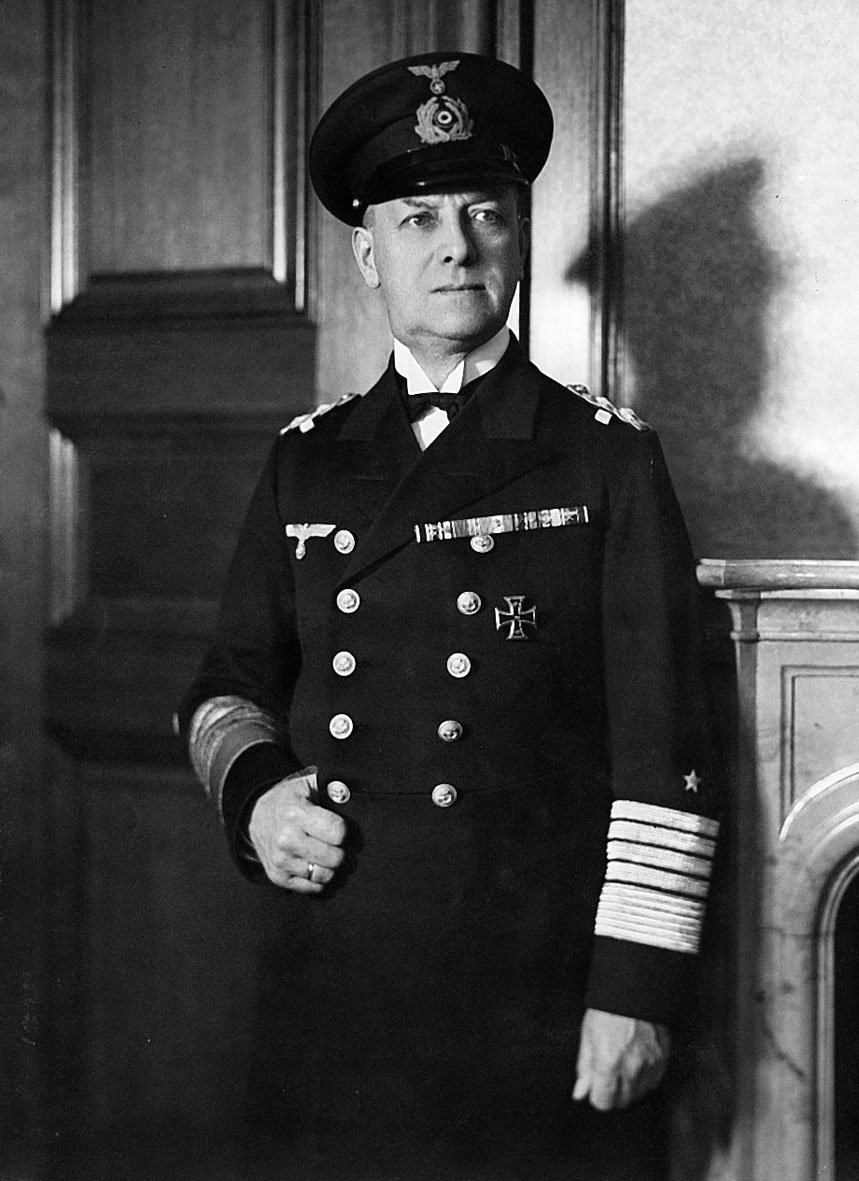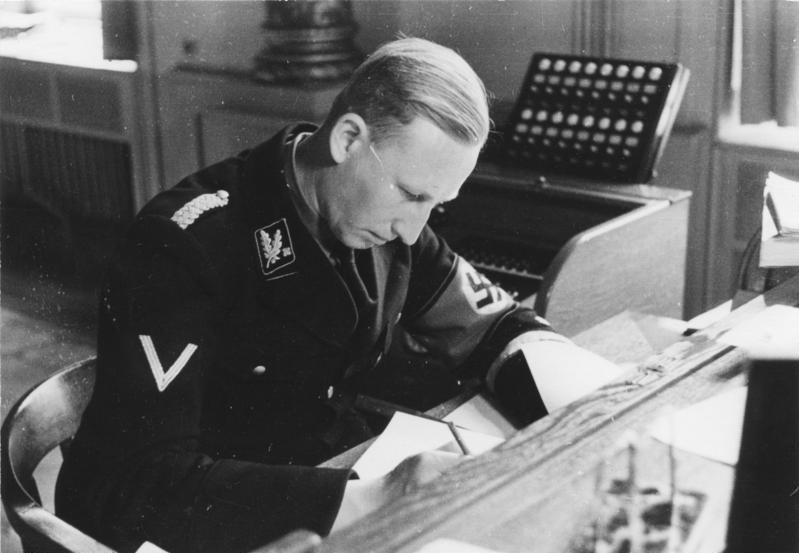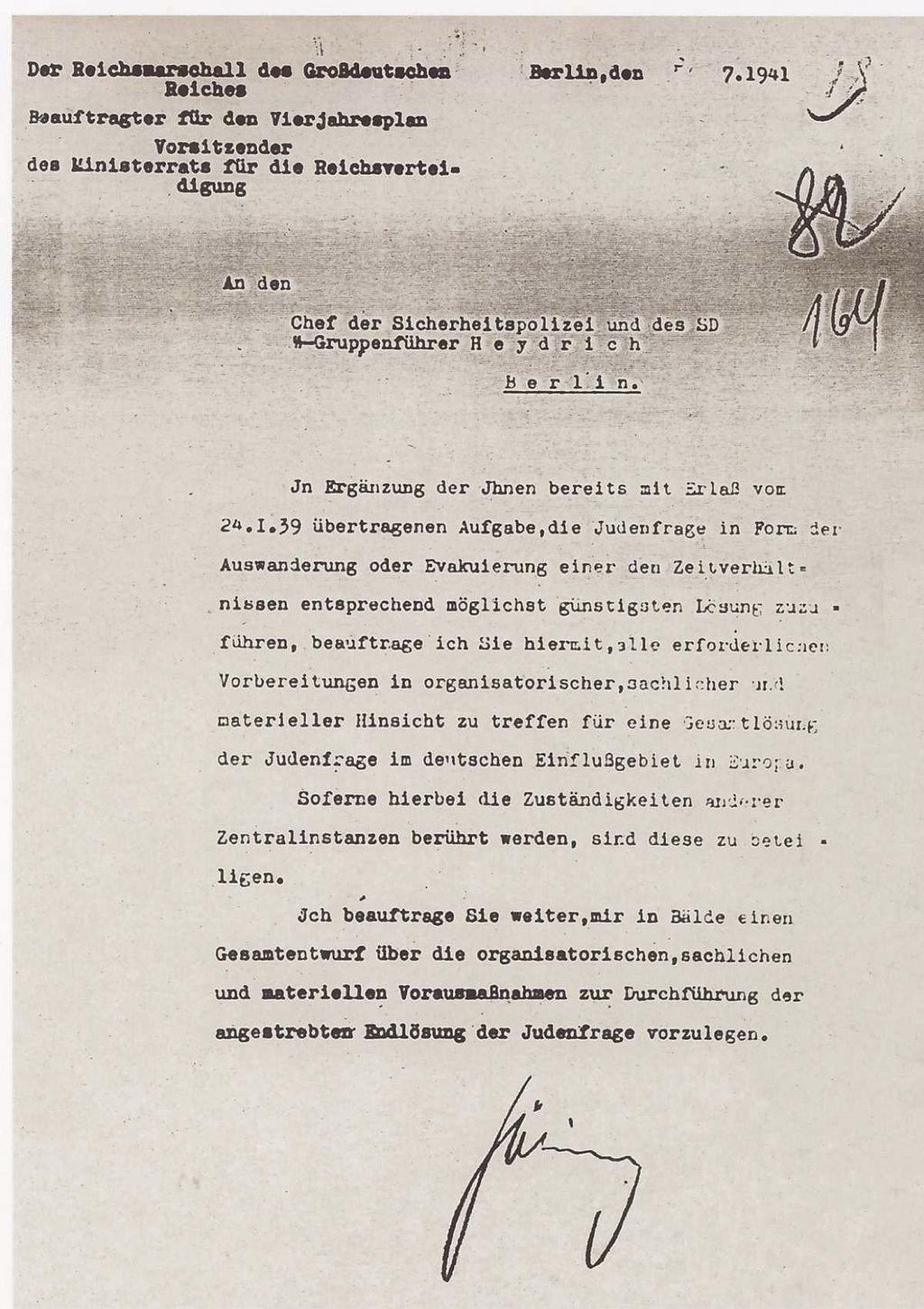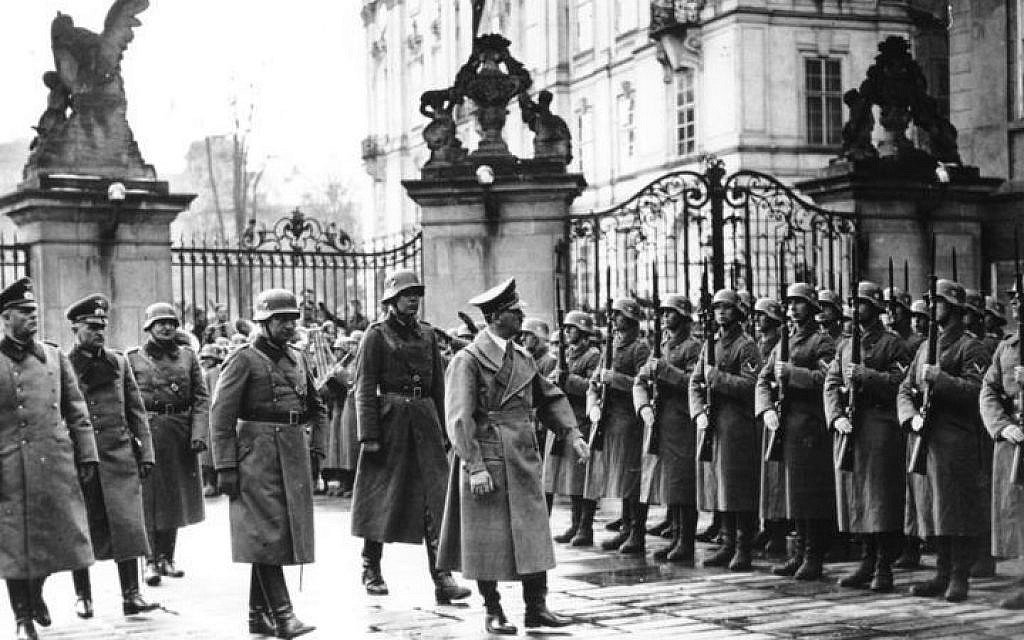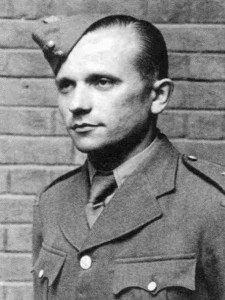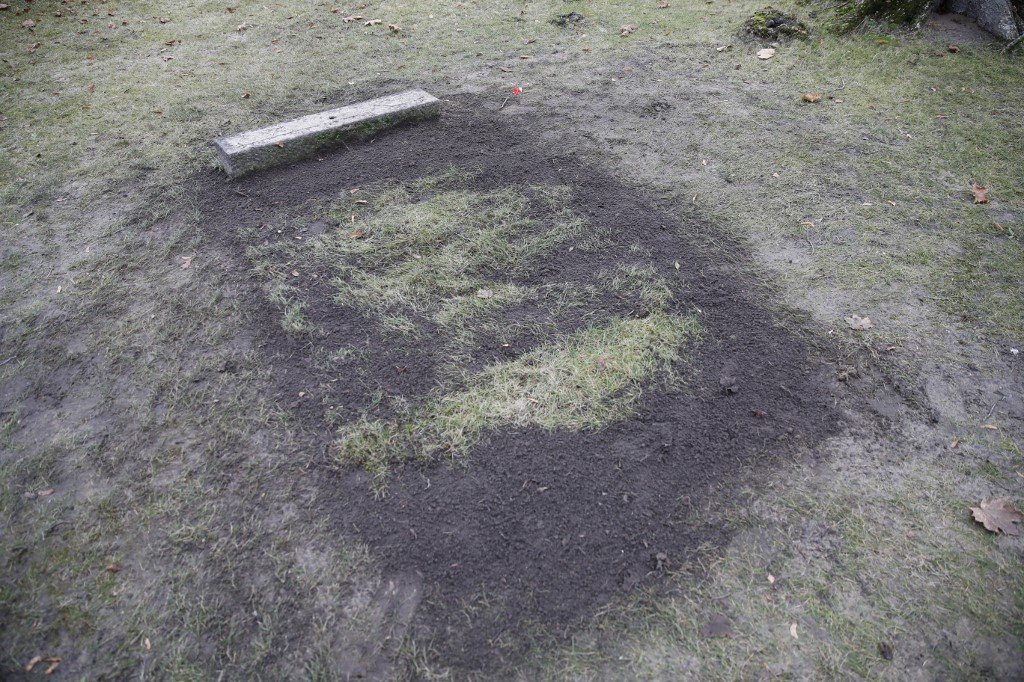Reinhard Heydrich
"The Hangman", "the Butcher of Prague", "the Blond Beast", and "the Man with the Iron Heart".
Early life
Reinhard Tristan Eugen Heydrich was born in 1904 in Halle an der Saale to composer and opera singer Richard Bruno Heydrich and his wife, Elisabeth Anna Maria Amalia Heydrich (née Krantz). His father came from a Protestant family, but converted to Elisabeth's Roman Catholic faith upon marriage. Reinhard was an altar boy, attending evening prayers and Mass every week with his mother as part of the Catholic minority in Halle. Two of his forenames were musical references: "Reinhard" referred to the hero from his father's opera Amen, and "Tristan" stems from Richard Wagner's Tristan und Isolde. Heydrich's third name, "Eugen", was his late maternal grandfather's forename (Eugen Krantz had been the director of the Dresden Royal Conservatory). He learned the piano and violin by the time he was six years old. Heydrich developed a passion for the violin and carried that interest into adulthood; he impressed listeners with his musical talent
His father was a German nationalist with loyalties to the Kaiser, who instilled patriotic ideas in his three children but was not affiliated with any political party until after World War I. The household was strict. Heydrich, initially a frail and sickly youth, was encouraged by his parents to exercise to build up his strength. He engaged his younger brother, Heinz, in mock fencing duels. He excelled in his schoolwork at the secular "Reformgymnasium", especially in the sciences. A talented athlete, he became an expert swimmer and fencer. He was shy, insecure, and was frequently bullied for his high-pitched voice and rumoured Jewish ancestry. These rumours increased after his maternal uncle Hans Krantz married a Hungarian Jew named Iza Jarmy. However, the family maintained cordial relations with the Jewish community; many Jewish students attended the Halle Conservatory, and its cellar was rented out to a Jewish salesman. Heydrich was friends with Abraham Lichtenstein, son of the cantor.
In 1918, World War I ended with Germany's defeat. In late February 1919, civil unrest—including strikes and clashes between communist and anti-communist groups—took place in Heydrich's home town of Halle. Heydrich began to form positive opinions about the Völkisch movement and anti-communism, as well as a distaste for the Treaty of Versailles and the positioning of the German-Polish border. Heydrich stated he joined the Deutschvölkischer Schutz- und Trutzbund (National German Protection and Shelter League), an antisemitic organisation.
Naval Career
In 1922, Heydrich joined the German Navy (Reichsmarine), taking advantage of the security, structure, and pension it offered. He became a naval cadet at Kiel, Germany's primary naval base. Many of Heydrich's fellow cadets falsely regarded him as Jewish. To counteract these rumours, Heydrich told people he had joined several antisemitic and nationalist organisations, such as the Deutschvölkischer Schutz und Trutzbund. On 1 April 1924 he was promoted to senior midshipman (Oberfähnrich zur See) and sent to officer training at the Naval Academy Mürwik. In 1926 he advanced to the rank of ensign (Leutnant zur See) and was assigned as a signals officer on the battleship SMS Schleswig-Holstein, the flagship of Germany's North Sea Fleet. With the promotion came greater recognition. He received good evaluations from his superiors and had few problems with other crewmen. He was promoted on 1 July 1928 to the rank of first lieutenant.
Heydrich became notorious for his countless affairs. In December 1930 he attended a rowing-club ball and met Lina von Osten. They became romantically involved and soon announced their engagement. Lina was already a Nazi Party follower and antisemite; she had attended her first rally in 1929. Early in 1931 Heydrich was charged with "conduct unbecoming an officer and a gentleman" for a breach of promise, having been engaged to marry another woman he had known for six months before the Lina von Osten engagement. Admiral Erich Raeder dismissed Heydrich from the navy in April. He received severance pay of 200 Reichsmarks (equivalent to €755 in 2021) a month for the next two years. Heydrich married Lina in December 1931.
Reinhard & Lina Heydrich
SMS Schleswig Holstein
Admiral Erich Raeder
NAZI Career
In 1931, Heinrich Himmler began setting up a counterintelligence division of the SS. Acting on the advice of his associate Karl von Eberstein, who was Lina's friend and Heydrich's godbrother, Himmler agreed to interview Heydrich, but cancelled their appointment at the last minute. Lina ignored this message, packed Heydrich's suitcase, and sent him to Munich. Eberstein met Heydrich at the railway station and took him to see Himmler. Himmler asked Heydrich to convey his ideas for developing an SS intelligence service. Himmler was so impressed that he hired Heydrich immediately.
In mid-1932, Himmler appointed Heydrich chief of the renamed security service—the Sicherheitsdienst (SD). Heydrich's counterintelligence service grew into an effective machine of terror and intimidation. With Hitler striving for absolute power in Germany, Himmler and Heydrich wished to control the political police forces of all 17 German states. They began with Bavaria. In 1933, Heydrich gathered some of his men from the SD and together they stormed police headquarters in Munich and took over the organisation using intimidation tactics. Himmler became the Munich police chief and Heydrich became the commander of Department IV, the political police.
In 1933, Hitler became Chancellor of Germany, and through a series of decrees became Germany's Führer und Reichskanzler (leader and chancellor). The first concentration camps, which were originally intended to house political opponents, were established in early 1933. By year's end there were over fifty camps.
Hermann Göring founded the Gestapo in 1933 as a Prussian police force. When Göring transferred full authority over the Gestapo to Himmler in April 1934, it immediately became an instrument of terror under the SS's purview. Himmler named Heydrich to head the Gestapo on 22 April 1934. Also in April, Göring made Heydrich an advisor to the Prussian government with an appointment to the Prussian State Council. On 9 June 1934, Rudolf Hess declared the SD the official Nazi intelligence service
Night of the Long Knives
Beginning in April 1934, and at Hitler's request, Heydrich and Himmler began building a dossier on Sturmabteilung (SA) leader Ernst Röhm in an effort to remove him as a rival for party leadership. At this point, the SS was still part of the SA, the early Nazi paramilitary organisation which now numbered over 3 million men. At Hitler's direction, Heydrich, Himmler, Göring, and Viktor Lutze drew up lists of those who should be killed, starting with seven top SA officials and including many more. On 30 June 1934 the SS and Gestapo acted in coordinated mass arrests that continued for two days. Röhm was shot without trial, along with the leadership of the SA. The purge became known as the Night of the Long Knives. Up to 200 people were killed in the action. Lutze was appointed SA's new head and it was converted into a sports and training organisation.
With the SA out of the way, Heydrich began building the Gestapo into an instrument of fear. He improved his index-card system, creating categories of offenders with colour-coded cards. The Gestapo had the authority to arrest citizens on the suspicion that they might commit a crime, and the definition of a crime was at their discretion. The Gestapo Law, passed in 1936, gave police the right to act extra-legally. This led to the sweeping use of Schutzhaft—"protective custody", a euphemism for the power to imprison people without judicial proceedings. The courts were not allowed to investigate or interfere. The Gestapo was considered to be acting legally as long as it was carrying out the leadership's will. People were arrested arbitrarily, sent to concentration camps, or killed
Heydrich planning the downfall of the SA
SS officers and their wives
Heydrich at the Wannsee conference January 1942
1938 telegram giving orders during Kristallnacht, signed by Heydrich
Reich Protector of Bohemia and Moravia
On 27 September 1941, Heydrich was appointed Deputy Reich Protector of the Protectorate of Bohemia and Moravia (the part of Czechoslovakia incorporated into the Reich on 15 March 1939) and assumed control of the territory. The Reich Protector, Konstantin von Neurath, remained the territory's titular head, but was sent on "leave" because Hitler, Himmler, and Heydrich felt his "soft approach" to the Czechs had promoted anti-German sentiment and encouraged anti-German resistance via strikes and sabotage. Upon his appointment, Heydrich told his aides: "We will Germanize the Czech vermin."
Heydrich came to Prague to enforce policy, fight resistance to the Nazi regime, and keep up production quotas of Czech motors and arms that were "extremely important to the German war effort". He viewed the area as a bulwark of Germandom and condemned the Czech resistance's "stabs in the back". To realise his goals, Heydrich demanded racial classification of those who could and could not be Germanized. He explained, "Making this Czech garbage into Germans must give way to methods based on racist thought."
Heydrich started his rule by terrorising the population: he proclaimed martial law, and 142 people were executed within five days of his arrival in Prague. Their names appeared on posters throughout the occupied country. Most of them were the members of the resistance that had previously been captured and were awaiting trial.
According to Heydrich's estimate, between 4,000 and 5,000 people were arrested and between 400 and 500 were executed by February 1942. Those who were not executed were sent to Mauthausen-Gusen concentration camp, where only four per cent of Czech prisoners survived the war. Czech prime minister Alois Eliáš was among those arrested the first day. He was put on trial in Berlin and sentenced to death, but was kept alive as a hostage. He was later executed in retaliation for Heydrich's assassination.
As Acting Reich Protector of Bohemia and Moravia, Heydrich applied carrot-and-stick methods. Labor was reorganised on the basis of the German Labour Front. Heydrich used equipment confiscated from the Czech gymnastics organisation Sokol to organise events for workers. Food rations and free shoes were distributed, pensions were increased, and (for a time) free Saturdays were introduced. Unemployment insurance was established for the first time. The black market was suppressed. Those associated with it or the resistance movement were tortured or executed. Heydrich labelled them "economic criminals" and "enemies of the people", which helped gain him support. Conditions in Prague and the rest of the Czech lands were relatively peaceful under Heydrich, and industrial output increased Still, those measures could not hide shortages and increasing inflation; reports of growing discontent multiplied.
Despite public displays of goodwill towards the populace, privately Heydrich was very clear about his eventual goal: "This entire area will one day be definitely German, and the Czechs have nothing to expect here." Eventually up to two-thirds of the populace were to be either removed to regions of Russia or exterminated after Nazi Germany won the war. Bohemia and Moravia faced annexation directly into the German Reich.
Heydrich was, for all intents and purposes, military dictator of Bohemia and Moravia. His changes to the government's structure left President Emil Hácha and his cabinet virtually powerless. He often drove alone in a car with an open roof – a show of his confidence in the occupation forces and in his government's effectiveness.
By 3 October 1941, Czechoslovak military intelligence in London had made the decision to kill Heydrich.
July 1941 letter from Göring to Heydrich concerning the Final Solution of the Jewish question
In Charge
In January 1937, Heydrich directed the SD to secretly begin collecting and analysing public opinion and report back its findings. He then had the Gestapo carry out house searches, arrests, and interrogations, thus in effect exercising control over public opinion. In February 1938 when the Austrian Chancellor Kurt Schuschnigg resisted Hitler's proposed merger with Germany, Heydrich intensified the pressure on Austria by organising Nazi demonstrations and distributing propaganda in Vienna emphasising the common Germanic blood of the two countries. In the Anschluss on 12 March, Hitler declared the unification of Austria with Nazi Germany.
In mid-1939, Heydrich created the Stiftung Nordhav Foundation to obtain real estate for the SS and Security Police to use as guest houses and vacation spots. The Wannsee Villa, which the Stiftung Nordhav (Nordhav-Stiftung or Nordhav Foundation was a front organization of the Sicherheitsdienst (SD) founded in 1939 by Reinhard Heydrich to obtain and manage real estate for the SS.) acquired in November 1940, was the site of the Wannsee Conference (20 January 1942). Heydrich was the lead speaker. At Wannsee, senior Nazi officials formalised plans to deport and exterminate all Jews in German-occupied territory and those countries not yet conquered. This action was to be coordinated among the representatives from the Nazi state agencies present at the meeting.
On 27 September 1939, the SD and SiPo—made up of the Gestapo and the Criminal Police, or Kripo—were folded into the new Reich Security Main Office or Reichssicherheitshauptamt (RSHA), which was placed under Heydrich's control.
Hitler visits Prague Castle March 15th 1939
Heidrich & Hans Frank at Prague castle
Heidrich moves in to his office at the Castle
Role in the Holocaust
Historians regard Heydrich as the most fearsome member of the Nazi elite. Hitler called him "the man with the iron heart". He was one of the main architects of the Holocaust during the early war years, answering to and taking orders from only Hitler, Göring, and Himmler in all matters pertaining to the deportation, imprisonment, and extermination of Jews.
Heydrich was one of the organisers of Kristallnacht, a pogrom against Jews throughout Germany on the night of 9–10 November 1938. Heydrich sent a telegram that night to various SD and Gestapo offices, helping to coordinate the pogrom with the SS, SD, Gestapo, uniformed police (Orpo), SA, Nazi party officials, and even the fire departments. In the telegram, Heydrich granted permission for arson and destruction of Jewish businesses and synagogues, and ordered the confiscation of all "archival material" from Jewish community centres and synagogues.
On Himmler's instructions, Heydrich formed the Einsatzgruppen (task forces) to travel in the wake of the German armies at the start of World War II. On 21 September 1939, Heydrich sent out a teleprinter message on the "Jewish question in the occupied territory" to the chiefs of all Einsatzgruppen with instructions to round up Jewish people for placement into ghettos, called for the formation of Judenräte (Jewish councils), ordered a census, and promoted Aryanization plans for Jewish-owned businesses and farms, among other measures. The Einsatzgruppen units followed the army into Poland to implement the plans. Later, in the Soviet Union, they were charged with rounding up and murdering Jews via firing squad and gas vans. Historian Raul Hilberg estimates that between 1941 and 1945 the Einsatzgruppen and related auxiliary troops murdered more than two million people, including 1.3 million Jews.
On 10 October 1941, Heydrich was the senior officer at a "Final Solution" meeting of the RSHA in Prague that discussed deporting 50,000 Jews from the Protectorate of Bohemia and Moravia to ghettos in Minsk and Riga. Given his position, Heydrich was instrumental in carrying out these plans since his Gestapo was ready to organise deportations in the West and his Einsatzgruppen were already conducting extensive killing operations in the East.
Earlier on 31 July 1941, Hermann Göring gave written authorisation to Heydrich to ensure the co-operation of administrative leaders of various government departments in the implementation of a "Final Solution to the Jewish question" in territories under German control. On 20 January 1942, Heydrich chaired a meeting, now called the Wannsee Conference, to discuss the implementation of the plan.
... the planned total measures are to be kept strictly secret ... the first prerequisite for the final aim ("Endziel") is the concentration of the Jews from the countryside into the larger cities.
Heydrich, September 1939
Gabčík & Kubiš and the aftermath of the Anti tank Mine.
Death
In London, the Czechoslovak government-in-exile resolved to kill Heydrich. Jan Kubiš and Jozef Gabčík headed the team chosen for the mission, trained by the British Special Operations Executive (SOE). On 28 December 1941 they parachuted into the Protectorate, where they lived in hiding, preparing for the mission.
On 27 May 1942, Heydrich planned to meet Hitler in Berlin. German documents suggest that Hitler intended to transfer him to German-occupied France where the French resistance was gaining ground. To get from his home to the airport, Heydrich would have to pass a section where the Dresden-Prague road merges with a road to the Troja Bridge. The junction in the Prague suburb of Libeň was well suited for the attack because motorists have to slow for a hairpin bend. As Heydrich's car slowed, Gabčík took aim with a Sten submachine gun, but it jammed and failed to fire. Heydrich ordered his driver, Klein, to halt and attempted to confront Gabčík rather than speed away. Kubiš, who had not been spotted by Heydrich or Klein, threw a converted anti-tank mine at the car as it stopped, which landed against the rear wheel. The explosion ripped through the right rear fender and wounded Heydrich, with metal fragments and fibres from the upholstery causing serious damage to his left side: he suffered major injuries to his diaphragm, spleen, and one lung, as well as a broken rib. Kubiš received a minor shrapnel wound to his face. After Kubiš fled, Heydrich ordered Klein to chase Gabčík on foot, but Gabčík escaped after he shot and wounded Klein.
A Czech woman went to Heydrich's aid and flagged down a delivery van. He was placed on his stomach in the back of the van and taken to the emergency room at Bulovka Hospital.
A splenectomy was performed, and the chest wound, left lung, and diaphragm were all debrided. Himmler ordered Karl Gebhardt to fly to Prague to assume care. Despite a fever, Heydrich's recovery appeared to progress well. Hitler's personal doctor Theodor Morell suggested the use of the new antibacterial drug sulfonamide, but Gebhardt thought that Heydrich would recover and declined the suggestion.
On 3 June, the day after Himmler's visit, Heydrich fell into a coma and never regained consciousness; he died on 4 June. An autopsy concluded that he died of sepsis. He was 38 years old
Aftermath
Heydrich's assailants hid in safe houses and eventually took refuge in Saints Cyril and Methodius Cathedral, an Orthodox church in Prague. After a traitor in the Czech resistance betrayed their location, the church was surrounded by 800 members of the SS and Gestapo. Several Czechs were killed, and the remainder hid in the church's crypt. The Germans attempted to flush the men out with gunfire and tear gas, and by flooding the crypt. Eventually an entrance was made using explosives. Rather than surrender, the soldiers killed themselves. Supporters of the assassins who were killed in the wake of these events included the church's leader, Bishop Gorazd, who is now revered as a martyr of the Orthodox Church.
Bullet-scarred window to the crypt of Saints Cyril and Methodius Cathedral in Prague, where Kubiš and his compatriots were cornered
Infuriated by Heydrich's death, Hitler ordered the arrest and execution of 10,000 randomly selected Czechs. But after consultations with Karl Hermann Frank, he altered his response. The Czech lands were an important industrial zone for the German military, and indiscriminate killing could reduce the region's productivity. Hitler ordered a quick investigation. Intelligence falsely linked the assassins to the towns of Lidice and Ležáky. A Gestapo report stated that Lidice, 22 kilometres (14 mi) north-west of Prague, was suspected as the assailants' hiding place because several Czech army officers, then in England, had come from there; additionally, the Gestapo had found a resistance radio transmitter in Ležáky. On 9 June, after discussions with Himmler and Karl Hermann Frank, Hitler ordered brutal reprisals. On 9 June, in the village of Lidice 172 boys and men between age 14 to 84 were shot. Thereafter, all adults in Ležáky were murdered.
All but four of the women from Lidice were deported immediately to Ravensbrück concentration camp (four were pregnant – they were subjected to forced abortions at the same hospital where Heydrich had died and the women were then sent to the concentration camp). Some children were chosen for Germanization, and 81 were murdered in gas vans at the Chełmno extermination camp. Both towns were burned and Lidice's ruins were levelled. Overall, at least 1,300 Czechs, including 200 women, were killed in reprisal for Heydrich's assassination.
Heydrich's replacements were Ernst Kaltenbrunner as the chief of RSHA, and Karl Hermann Frank (27–28 May 1942) and Kurt Daluege (28 May 1942 – 14 October 1943) as the new acting Reichsprotektors. After Heydrich's death, implementation of the policies formalised at the Wannsee conference he chaired was accelerated. The first three true death camps, designed for mass murder with no legal process or pretext, were built and operated at Treblinka, Sobibór, and Bełżec. The project was named Operation Reinhard after Heydrich.
Saints Cyril and Methodius Cathedral, The bullet scarred hideout and the childrens memorial at Lidice.
After an elaborate funeral held in Prague on 7 June 1942, Heydrich's coffin was placed on a train to Berlin, where a second ceremony was held in the new Reich Chancellery on 9 June. Himmler gave the eulogy. Hitler attended and placed Heydrich's decorations—including the highest grade of the German Order, the Blood Order Medal, the Wound Badge in Gold, and the War Merit Cross 1st Class with Swords—on his funeral pillow. Although Heydrich's death was employed for pro-Reich propaganda, Hitler privately blamed Heydrich for his own death, through carelessness:
“Since it is opportunity which makes not only the thief but also the assassin, such heroic gestures as driving in an open, unarmoured vehicle or walking about the streets unguarded are just damned stupidity, which serves the Fatherland not one whit. That a man as irreplaceable as Heydrich should expose himself to unnecessary danger, I can only condemn as stupid and idiotic”.
Heydrich was interred in Berlin's Invalidenfriedhof, a military cemetery. The exact burial spot is no longer public knowledge—a temporary wooden marker that disappeared when the Red Army overran the city in 1945 was never replaced, so that Heydrich's grave could not become a rallying point for Neo-Nazis. Nevertheless, on 16 December 2019, the BBC reported that Heydrich's unmarked grave had been opened by unknown persons, without anything being taken. A photograph of Heydrich's burial shows the wreaths and mourners to be in section A, which abuts the north wall of the Invalidenfriedhof and Scharnhorststraße, at the front of the cemetery. A recent biography of Heydrich also places the grave in Section A. Hitler planned for Heydrich to have a monumental tomb but due to Germany's declining fortunes, it was never built.
Heydrich's widow Lina won the right to a pension following a series of court cases against the West German government in 1956 and 1959. She was declared entitled to a substantial pension as her husband was a German general killed in action. The government had previously declined to pay due to Heydrich's role in the Holocaust. The couple had four children: Klaus, born in 1933, killed in a traffic accident in 1943; Heider, born in 1934; Silke, born in 1939; and Marte, born shortly after her father's death in 1942.
Second funeral ceremony, 9 June 1942
Heydrich's anonymous grave
Vandals in Berlin dig up grave of Reinhard Heydrich
Born
Reinhard Tristan Eugen Heydrich
7 March 1904
Halle an der Saale, Prussia, German Empire
Died 4 June 1942 (aged 38)
Prague-Libeň, Protectorate of Bohemia and Moravia
(now Prague, Czech Republic)
Reinhard Heydrich - The Man with the Iron Heart Documentary
The Man with the Iron Heart - Trailer
The Wannsee conference Movie
Anthropoid Official Trailer



